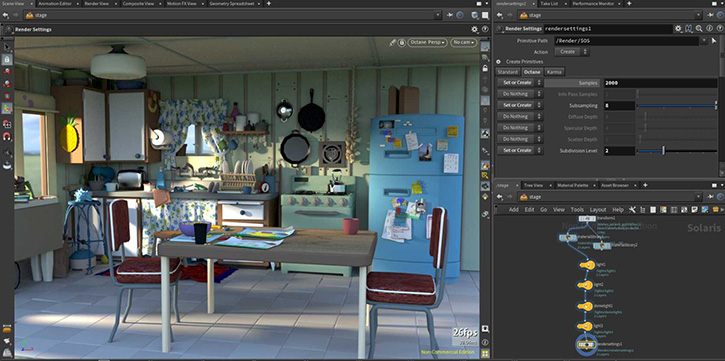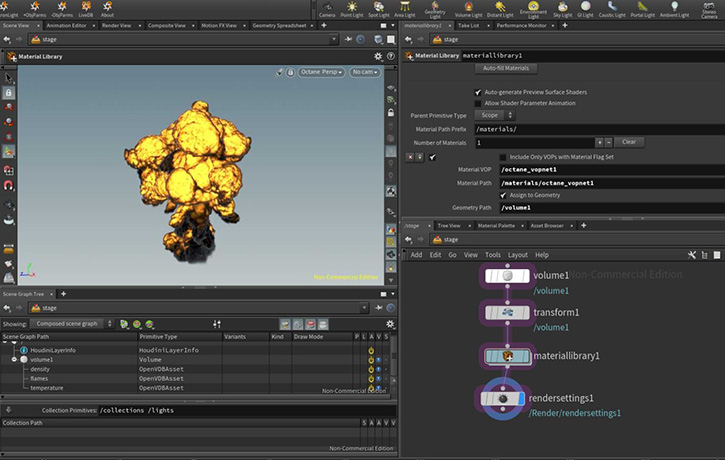OTOY® is proud to announce the availability of the new DCC plugin OctaneRender for Solaris V2021.1.4 - for Houdini 19.0.561.
The world's fastest unbiased GPU rendering engine on CUDA and Metal now integrate completely with Houdini 19.0 Solaris.
What is OctaneRender for Solaris?
The OctaneRender for Solaris plugin is based on Pixar’s USD (Universal Scene Description) and Pixar’s Hydra API to empower artist workflows across look development, scene layout, lighting, and final rendering.


Pixar's USD pipeline
https://renderman.pixar.com/stories/pixars-usd-pipeline
- Please note: OctaneSolaris is merged with the latest OctaneRender 2021.1 for Houdini build 2021.1.4.0 for Houdini 19.0.561, so no need to install the main plugin
-Installation steps-
Insert the OctaneRender® plugin folder path to the houdini.env file. Houdini®creates this file after launching it for the first time.
On Linux and macOS® systems, append a single line to enable OctaneRender®:
HOUDINI_PATH = "/path/to/octane;&"
On Windows® systems, you need to set the PATH to point to the plugin bin folder as well:
PATH = "C:/path/to/octane/bin;$PATH"
Setting this environment variable outputs any error related to loading the OctaneRender® plugin on the command line for diagnosing installation problems:
HOUDINI_DSO_ERROR = 2
-Houdnin Packages/json installation steps-
- Please create a folder inside Documents\houdini19.0 and name it as Packages
- Open notepad or any text editor and use these lines
Code: Select all
{
"enable" : true,
"env":
[
{
"OCTANE_AUTOSPAREPARAMS" :
{
"value": 1,
},
//location to your octane folder (example below)
"OCTVERSION": "PATH\TO\OCTANESOLARIS\Win64FOLDER",
},
{
"HOUDINI_PATH" :
{
"value": "$OCTVERSION",
},
"PATH" :
{
"value": "$OCTVERSION/bin",
},
"PXR_PLUGINPATH_NAME" :
{
//if you have the solaris version installed
"value": "$PATH\TO\OCTANESOLARIS\dso\usd_plugins",
},
}
]
}- Please make sure to disable the .env paths
New features
To learn more about the new features and improvements of OctaneRender 2021.1.3, please check out the 2021.1.1 release post
- Changes since 2021.1.4 - 04 25 22 [Test]-
- - Fixed crash when editing the distant light in an old scene setting the intensity to 0
- - Improved transparencies importing from the USD preview surface
-Known Issues-
- Octane Color response is disabled because Hydra buffer expects linear output
- Light Linker is yet to be supported as we are investigating if we could assign the Octane light IDs internally.
However, the usual Octane light linking works as expected.
===================================
Enterprise Subscription Downloads
===================================
2021.1.4 Houdini 19.0.561
===================================
Studio Subscription Downloads
===================================
2021.1.4 Houdini 19.0.561
===================================
Demo build Download
===================================
2021.1.4 Houdini 19.0.561
Happy GPU Rendering !!
Your team
OTOY



